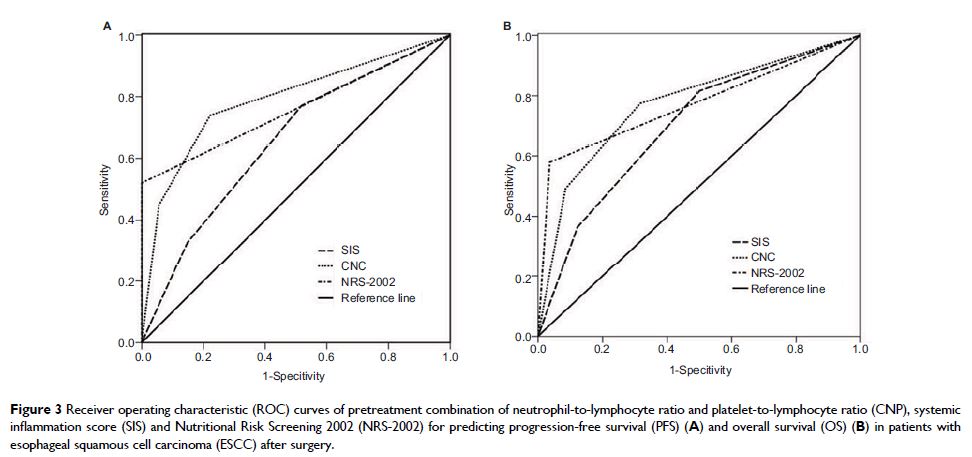108605
论文已发表
注册即可获取德孚的最新动态
IF 收录期刊
- 3.4 Breast Cancer (Dove Med Press)
- 3.2 Clin Epidemiol
- 2.6 Cancer Manag Res
- 2.9 Infect Drug Resist
- 3.7 Clin Interv Aging
- 5.1 Drug Des Dev Ther
- 3.1 Int J Chronic Obstr
- 6.6 Int J Nanomed
- 2.6 Int J Women's Health
- 2.9 Neuropsych Dis Treat
- 2.8 OncoTargets Ther
- 2.0 Patient Prefer Adher
- 2.2 Ther Clin Risk Manag
- 2.5 J Pain Res
- 3.0 Diabet Metab Synd Ob
- 3.2 Psychol Res Behav Ma
- 3.4 Nat Sci Sleep
- 1.8 Pharmgenomics Pers Med
- 2.0 Risk Manag Healthc Policy
- 4.1 J Inflamm Res
- 2.0 Int J Gen Med
- 3.4 J Hepatocell Carcinoma
- 3.0 J Asthma Allergy
- 2.2 Clin Cosmet Investig Dermatol
- 2.4 J Multidiscip Healthc

治疗前 NRS-2002 评分与血液学炎症标志物相结合是可切除的胸段食管鳞状细胞癌患者的独立预后因素
Authors Guo XW, Liu YC, Gao F, Ji SJ, Zhou JY, Ji L, Zhou SB
Received 3 March 2018
Accepted for publication 14 May 2018
Published 2 August 2018 Volume 2018:10 Pages 2409—2418
DOI https://doi.org/10.2147/CMAR.S167179
Checked for plagiarism Yes
Review by Single-blind
Peer reviewers approved by Dr Cristina Weinberg
Peer reviewer comments 2
Editor who approved publication: Professor Luzhe Sun
Background: The purpose of this study was to investigate the prognostic values
of Nutritional Risk Screening 2002 (NRS-2002) and hematologic inflammation
markers in patients with esophageal squamous cell carcinoma (ESCC) receiving
curative esophagectomy.
Materials and
methods: A total of 277 patients with ESCC
treated with standard curative esophagectomy were retrospectively analyzed.
These patients were grouped for further analysis according to the systemic
inflammation score (SIS), the combination of neutrophil-to-lymphocyte ratio and
platelet-to-lymphocyte ratio (CNP) score and NRS-2002 score. The Kaplan–Meier
method and log-rank test were adopted to calculate and compare the
progression-free survival (PFS) and overall survival (OS) rates with these
parameters. The Cox proportional hazards model was used to carry out univariate
and multivariate analyses. Receiver operating characteristic (ROC) curves were
applied to verify the accuracy of SIS, CNP and NRS-2002 for survival
prediction.
Results: In univariate analysis, the following factors were significantly
associated with poor PFS and OS: sex, T stage, N stage, TNM stage, SIS, CNP and
NRS-2002 (all P <0.05).
Furthermore, multivariate Cox regression analysis showed that CNP (hazard ratio
[HR]=1.602; 95% confidence interval [CI] 1.341–1.913; P =0.000), NRS-2002 (HR=2.062; 95%
CI 1.523–2.792; P =0.000) and TNM
stage (HR=1.194; 95% CI 1.058–1.565; P =0.048) were
independent prognostic factors for PFS. Correspondingly, CNP (HR=1.707; 95% CI
1.405–2.074; P =0.000), NRS-2002
(HR=2.716; 95% CI 1.972–3.740; P =0.000) and TNM
stage (HR=1.363; 95% CI 1.086–1.691; P =0.036) were
also independent prognostic factors for OS. Finally, the results of ROC curves
indicated that CNP and NRS-2002 were superior to SIS as a predictive factor for
PFS or OS in patients with ESCC receiving surgery.
Conclusion: This study demonstrated that CNP combined with NRS-2002 is
promising as a predictive marker for predicting clinical outcomes in patients
with ESCC receiving surgery.
Keywords: esophageal squamous cell carcinoma, surgery, hematological
markers, nutritional risk screening, prognosis
